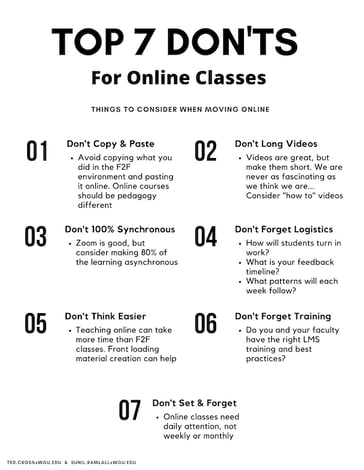Published on
What NOT to Do When Putting Your Classes Online

As part of the effort to ensure social distancing during the pandemic, universities sent students home en masse to learn online. However, it is estimated that 70% of faculty had never taught a virtual course previously (Hechinger & Lorin, 2020). The $600-billion-plus higher education industry faces critical decisions about whether to hold face-to-face, blended, or virtual courses in the fall. Even though the current crisis has moved almost everyone to the virtual classroom, online education had been growing rapidly before COVID-19. For instance, the latest report from the Babson Survey Research group noted that online enrollments grew for the 14th straight year on record to approximately 6.3 million students taking at least one virtual class in the U.S. In other words, online courses are not new, and they are especially not new to us at Western Governors University, where all courses are offered online, serving more than 120,000 students.
In the wake of the pandemic, most institutions are scrambling to put classes online. Fortunately, many institutions have a long history of successfully teaching online. While there are no widely accepted standards (besides Quality Matters) for designing online courses, there are generally accepted practices that can lead to effective learning experiences for students and faculty. Having spent ten plus years in online education, we offer a few insights on what not to do when migrating face-to-face or blended courses online.
Don’t copy and paste
What works in the face-to-face classroom will not necessarily work in the virtual classroom. For example, if a course is based on classroom discussion, it may be less valuable to ask students to log on to Zoom three times a week to participate in live sessions than it would be to have one live Zoom session a week combined with a threaded discussion forum. Or, it may be better to assign alternative materials, like podcasts, rather than just relying on a single textbook. Remember, students are disrupted and are looking for online courses to meet their needs, not fit the previous brick-and-mortar classroom model.
Don’t create long videos
Videos are great, but long video lectures are boring. Throughout our careers in online education, we have seen the value of using various multimedia resources to help students grasp course concepts and create a sense of personal connection between themselves and the instructor. Ultimately, instructors can make a positive difference through immediacy and presence by making small changes through general class-directed videos and short weekly video announcements (roughly three minutes in length) periodically throughout the course (Bialowas & Steimel, 2019). By breaking up lecture videos and announcement type videos, students have the chance to fit learning into smaller windows of free time.
Don’t make everything synchronous; consider a mix of synchronous and asynchronous
Synchronous online class meetings and well-structured small group meetings can help students feel a stronger sense of connection to their peers and instructors, which in turn keeps the, engaged with course activities (Yamagata-Lynch, 2014). The learning, motivation to learn, and retention of knowledge are maximized through synchronous activities that support asynchronous learning activities. But remember, most students are online because of life circumstances, make sure to create “on-demand” content and aides. For example, students at WGU participate in Facebook groups that are asynchronous in nature but allow students to bond and help each other move through their course work. Also, students are assigned to mentors that check in via phone calls periodically. Combining synchronous and asynchronous support is key.
Don’t forget logistics
How will students turn in work? How will it be graded? How will people work in groups? Too often, we do not focus on the details of assignments or other important aspects of an online course. Students will quickly feel that the quality of the course or even thoughtfulness of the faculty may have been impacted compared to previous experiences. Put yourself in the student’s shoes and walk through every aspect of the course from their perspective. Ask yourself what a student would need to know to be successful.
Don’t think that faculty are working less online—they’re working more
Whether we wish it or not, the instructor is often seen as the center of the classroom, the one who determines what to study, who keeps things moving and flowing in sessions, and, perhaps most importantly to students, assigns grades (Major, 2015). Given the importance instructors have in ensuring a rich learning experience, they spend significant amounts of time converting courses, reviewing and learning some of the technology during the process of migrating courses online.
Teaching online takes more planning, material creation, video recording, building of course shells, creation of weekly discussions and quality assurance interventions among others. To reiterate our previously mentioned point, migrating face-to-face courses online is not a cut-and-paste initiative. It is critical to develop the courses to ensure the highest possible levels of student engagement and relevance, and to maximize learning
Don’t forget training
Consider providing training to faculty on your online model and best practices in the virtual classroom. Like all change management interventions, transitioning to online teaching requires learning new skills. Using technology, setting up a course shell, recording videos and all aspects of teaching online require training and mentoring.
Don’t set it and forget it
Putting a course online does not mean you can “set it and forget it.” Continuously evaluating course performance, engagement and student feedback should always guide instructors to make changes to their online courses. Also, it is important for faculty members to be visible and present. Years of research on online student engagement show that active participation by faculty and staff keeps students learning.
For example, a study by Ramlall & Ramlall (2016) identified the following factors in helping maximize success and satisfaction in a course.
1. Faculty are visible in the discussions and respond to each student at least once.
2. Feedback on assignments should be given within three or four days days after the assignment’s due date.
3. Faculty challenge students’ thinking and comments in class discussions.
4. They provide individual feedback and specific, personalized comments.
5. They provide qualitative and quantitative feedback.
6. They share personal experiences and examples.
7. They reflect on the literature or at least share a relevant citation from which students can gain deeper insights.
8. They provide weekly announcements on what will be covered for the week and highlight the transition from the previous week.
Conclusion
While there continues to be a scramble to convert courses to online learning modalities, the cost is not necessarily the most significant factor. Most academic institutions already have learning management systems without necessarily having all their courses online. The migration to online is about more than the technical aspect, it is also a mindset change for administrators, faculty, staff, students and employers. Online learning is the future, and the future has arrived. As such, thinking through best practices in teaching, designing and administering online programs will become more and more important.

References
Bialowas, A., & Steimel, S. (2019). Less Is More: Use of Video to Address the Problem of
Teacher Immediacy and Presence in Online Courses. International Journal of Teaching
and Learning in Higher Education, 31(2), 354–364.
Brinkley-Etzkorn, K. E. (2018). Learning to teach online: Measuring the influence of faculty
development training on teaching effectiveness through a TPACK lens. The Internet and
Higher Education, 38, 28–35
Hechinger, J., & Lorin, J. (2020). Coronavirus Forces $600 Billion Higher Education Industry Online. Bloomberg.com, N.PAG-N.PAG.
Major, C. H. (2015). Teaching Online : A Guide to Theory, Research, and Practice. Johns
Hopkins University Press.
Ramlall, S. & Ramlall, D. (2016). An Effective MBA: Perspectives of Students, Faculty, and
Employers. Journal of Management & Strategy, 7(3), 18-22.
Seaman, J. E., Allen, I. E., Seaman, J., & Babson Survey Research Group. (2018). Grade Increase: Tracking Distance Education in the United States. Babson Survey Research Group. Babson College, 231 Forest Street, Babson Park, MA 02457. Tel: 909-278-7389; Web site: http://www.babson.edu/Academics/centers/blank-center/global-research/Pages/babson-survey-research-group.aspx.
Stark, E. (2019). Examining the Role of Motivation and Learning Strategies in Student Success in Online versus Face-to-Face Courses. Online Learning, 23(3), 234-251.
Yamagata-Lynch, L. C. (2014). Blending Online Asynchronous and Synchronous Learning. International Review of Research in Open & Distance Learning, 15(2), 189–212.



